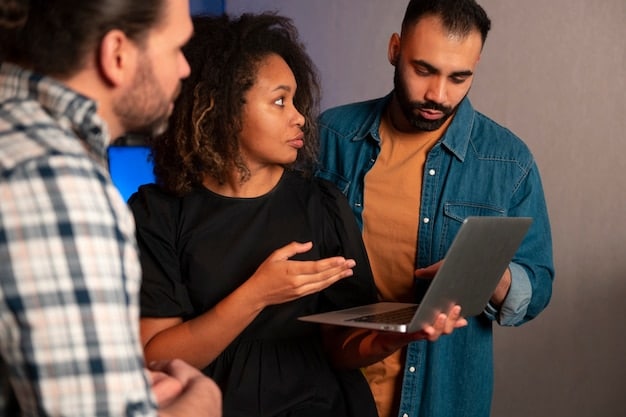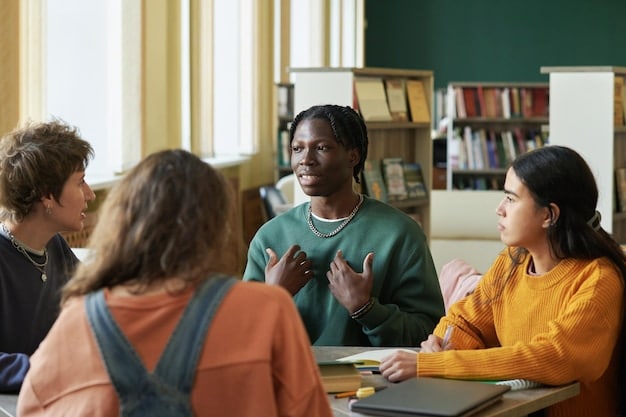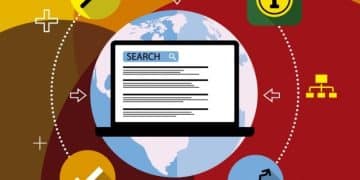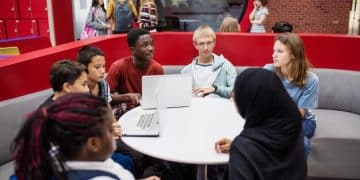Promoting Media Literacy: Critical Thinking Skills vs. Misinformation

Promoting media literacy and critical thinking skills is crucial to combat misinformation by empowering individuals to evaluate information critically, discern credible sources, and understand the biases that can lead to the spread of false narratives.
In today’s digital age, where information spreads rapidly, the ability to distinguish fact from fiction is more critical than ever. This is where media literacy and critical thinking skills play a vital role. Let’s explore how can we promote media literacy and critical thinking skills to combat misinformation, ensuring a more informed and discerning society.
Understanding Media Literacy and Critical Thinking
Media literacy goes beyond simply reading the news; it involves analyzing, evaluating, and creating media in various forms. Critical thinking, on the other hand, is the ability to analyze information objectively and make reasoned judgments. Together, these skills empower individuals to navigate the complex information landscape.
The Importance of Media Literacy
Media literacy helps individuals understand the underlying messages, biases, and intentions behind the information they consume. It equips them with the tools to question and evaluate the content rather than passively accepting it.

The Role of Critical Thinking
Critical thinking involves logical reasoning and objective analysis. It enables individuals to assess the credibility of sources, identify logical fallacies, and form their own well-informed opinions.
- Evaluating Sources: Determining the reliability and credibility of information sources.
- Identifying Bias: Recognizing the presence of bias in media content.
- Understanding Context: Analyzing information within its broader context.
In summary, media literacy and critical thinking skills are essential tools for navigating the complex information landscape. By empowering individuals to analyze, evaluate, and create media, we can foster a more informed and discerning society.
Integrating Media Literacy in Education
One of the most effective ways to promote media literacy is by integrating it into the education system. From primary schools to higher education, incorporating media literacy curricula can equip students with essential skills for the digital age.
Early Introduction in Primary Schools
Introducing basic media literacy concepts in primary schools can lay a strong foundation. Simple activities, such as discussing the difference between entertainment and news, can help children start thinking critically about the media they consume.
Comprehensive Curriculum in Secondary Education
Secondary education should offer a more comprehensive approach, teaching students how to analyze news articles, identify fake news, and understand the role of social media. Practical exercises can reinforce these concepts.

Higher Education and Specialized Courses
Universities and colleges can offer specialized courses in media literacy, journalism, and communication studies. These courses can provide in-depth knowledge and skills for those pursuing careers in media-related fields.
- Analyzing Media Messages: Understanding how media content is constructed.
- Producing Media Content: Creating responsible and ethical media.
- Engaging with Media Critically: Questioning media narratives and sources.
Integrating media literacy into education is crucial for preparing future generations to be informed and responsible citizens. By starting early and offering comprehensive curricula, we can equip students with the skills they need to navigate the digital age.
Empowering Communities Through Workshops and Training Programs
Beyond formal education, community-based workshops and training programs play a crucial role in promoting media literacy. These initiatives can reach diverse audiences, including adults, seniors, and underserved communities.
Targeted Workshops for Adults
Workshops designed for adults can focus on practical skills, such as identifying phishing scams, evaluating online sources, and protecting personal information. These sessions can be tailored to specific needs and interests.
Training Programs for Seniors
Seniors are particularly vulnerable to misinformation. Training programs can help them navigate social media, identify fake news, and understand the basics of online security. These programs should be accessible and easy to understand.
Reaching Underserved Communities
Underserved communities often lack access to reliable information and resources. Workshops and training programs can bridge this gap by providing them with essential media literacy skills and resources.
Community workshops and training programs are essential for promoting media literacy among diverse populations. By tailoring these initiatives to specific needs and interests, we can empower individuals to navigate the digital landscape with confidence and discernment.
Leveraging Technology to Enhance Media Literacy
Technology can be a powerful tool for promoting media literacy. From interactive apps to online courses, technology can make learning engaging and accessible to a wide audience.
Educational Apps and Games
Interactive apps and games can teach media literacy skills in a fun and engaging way. These tools can help users practice identifying fake news, evaluating sources, and understanding media biases.
Online Courses and Webinars
Online courses and webinars offer flexible learning options for individuals who cannot attend in-person workshops. These platforms can cover a wide range of topics, from basic media literacy to advanced critical thinking.
Social Media Campaigns
Social media platforms can be used to run campaigns that promote media literacy. Short videos, infographics, and interactive quizzes can help raise awareness and educate users about critical thinking skills.
- Engaging Content: Creating content that is visually appealing and easy to understand.
- Interactive Activities: Incorporating quizzes, polls, and other interactive elements.
- Targeted Messaging: Tailoring messages to specific audiences and platforms.
By leveraging technology, we can enhance media literacy and reach a wider audience. Interactive apps, online courses, and social media campaigns can make learning engaging, accessible, and effective.
Strengthening Journalistic Standards and Ethics
Ethical journalism plays a critical role in combating misinformation. By upholding high standards of accuracy, fairness, and transparency, journalists can help build trust and credibility in the media.
Promoting Ethical Reporting
Journalism schools and professional organizations should emphasize the importance of ethical reporting. Training programs can teach journalists how to verify information, avoid bias, and report accurately.
Fact-Checking and Verification
Fact-checking has become an essential part of journalism. News organizations should invest in fact-checking resources and hold journalists accountable for accuracy.
Transparency and Accountability
Transparency is crucial for building trust. News organizations should be open about their sources, methods, and corrections. They should also be accountable for their mistakes.
Strengthening journalistic standards and ethics is essential for combating misinformation. By promoting ethical reporting, fact-checking, and transparency, we can help build trust and credibility in the media.
Collaborating Across Sectors to Combat Misinformation
Combating misinformation requires a collaborative effort across various sectors, including government, media, education, and civil society. By working together, these stakeholders can create a more informed and resilient society.
Government Initiatives
Governments can support media literacy initiatives through funding, policy, and public awareness campaigns. They can also work with social media platforms to address the spread of misinformation.
Media Partnerships
Media organizations can partner with educational institutions and community groups to promote media literacy. They can also collaborate on fact-checking initiatives and public service announcements.
Educational Programs
Schools and universities can integrate media literacy into their curricula and offer training programs for teachers and students. They can also partner with media organizations to provide real-world learning experiences.
Civil Society Engagement
Civil society organizations can raise awareness about misinformation and promote critical thinking skills. They can also advocate for policies that support media literacy and transparency.
- Sharing Resources: Pooling resources and expertise to maximize impact.
- Coordinating Efforts: Aligning strategies and initiatives to avoid duplication.
- Building Trust: Fostering trust and collaboration among stakeholders.
Collaborating across sectors is crucial for combating misinformation effectively. By working together, government, media, education, and civil society can create a more informed and resilient society.
| Key Aspect | Brief Description |
|---|---|
| 🍎 Education Integration | Incorporating media literacy into school curricula from primary to higher education. |
| 🧑🤝🧑 Community Workshops | Offering targeted workshops for adults and training programs for seniors. |
| 📱 Tech Leverage | Using apps, online courses, and social media campaigns to enhance media literacy. |
| 📰 Ethical Journalism | Strengthening standards through fact-checking and transparency. |
FAQ
▼
Media literacy is the ability to access, analyze, evaluate, and create media. It’s crucial because it helps individuals understand and navigate the vast amount of information they encounter daily, distinguishing credible sources from misinformation.
▼
Schools can integrate media literacy by teaching students how to evaluate sources, identify bias, and understand the construction of media messages. Practical exercises like analyzing news articles and creating their own media can reinforce these skills.
▼
Social media platforms can inadvertently spread misinformation due to the ease of sharing content and the lack of strict editorial oversight. Algorithms can also create echo chambers, reinforcing existing beliefs, whether accurate or not.
▼
Adults can improve their media literacy by participating in workshops, taking online courses, and actively practicing critical thinking when consuming media. It’s helpful to cross-reference information from multiple sources and evaluate their credibility.
▼
Strategies for identifying fake news include checking the source’s reputation, verifying the information with other credible sources, scrutinizing the website’s design, and being wary of sensational headlines or emotional appeals. Fact-checking websites can also be valuable resources.
Conclusion
In conclusion, promoting media literacy and critical thinking skills is essential for combating misinformation in our increasingly digital world. By integrating these skills into education, empowering communities, leveraging technology, strengthening journalistic standards, and fostering collaboration across sectors, we can create a more informed, discerning, and resilient society capable of navigating the complexities of modern media.





